Catch those dental problems at a young age
View(s):
Thumbsucking at infancy may lead to malocclusion. Pic by Indika Handuwala
Keep an eye on the ‘milk’ teeth of your children, is the advice of Consultant Orthodontist Dr. Thushari Dewanarayana to all parents. Giving pointers how a child’s smile can be enhanced, she urges parents to get an orthodontic assessment of their children when they are around 7 to 8 years old. Catching such problems when the children are young will help to investigate “anything” abnormal followed by the right treatment.
Before getting her teeth into some of the problems that may crop up, Dr. Dewanarayana explains that ‘Orthodontics’ is the branch of dentistry linked to the prevention and treatment of irregularities of the teeth and the jaws. Orthodontics deals with aesthetics, function and stability of dentition.
Next she opens wide the mouth and gives an insight on the development of dentition over three distinct phases:
- Deciduous dentition is the eruption of 20 deciduous teeth/milk teeth when the child is in the age group — 6 months to 3 years.
- Mixed dentition is when there is the presence of milk teeth and permanent teeth
- Permanent dentition, the final phase, comes with the loss of the last deciduous tooth.
Explaining that sometimes children’s jaws and teeth do not develop properly, Dr. Dewanarayana says that ‘malocclusion’ which means ‘bad bite’ occurs then. It involves crooked and misaligned teeth and a fault in the relation between the bottom and the top set of teeth.
“Generally, malocclusion does not affect physical health. It is also not a disease but a variation in the normal position of the teeth. However, it may impact on the shape of a person’s face and the appearance of his/her teeth, which can create embarrassment and cause a loss in self-confidence and even depression,” she says, adding that severe malocclusions may affect eating, speech and efforts to keep the teeth clean and also pain in the temporomandibular joints.

Dr. Thushari Dewanarayana
Orthodontic procedures, MediScene learns, involve prevention, interception or comprehensive treatment. According to Dr. Dewanarayana:
- Prevention – entails certain procedures undertaken in anticipation of the development of a problem; patient and parent education; supervision of growth and development not only of dentition but also of the craniofacial structure; diagnostic procedures to predict the appearance of malocclusion; and treatment procedures to prevent the onset of malocclusion.
- Interception – is the diagnosis and treatment of malocclusions as soon as they are detected in the developing dentition.
- Comprehensive – the orthodontic treatment carried out to correct the malocclusion of the teeth and the jaws.
Reiterating that it is always better to prevent or perform interceptive procedures, she gives the danger signals of malocclusion as:
- Early loss of primary (milk) teeth – this can cause a loss of space for the permanent teeth to erupt, leading to crowding. The primary teeth guide the eruption of the permanent teeth and act as ‘natural space maintainers’ for permanent teeth. Usually, dental caries is the main cause for the early loss of primary teeth.
In these cases, it is important to give oral hygiene instructions and dietary advice, along with the application of Fluoride gel. Routine reviews of the child’s teeth to prevent dental caries are also available.
Pointing out that in caries management, it is important to restore the teeth to their normal morphology, she adds that even the roots of the affected teeth should not be removed unless there is acute infection. If, however, the removal of teeth is unavoidable, it is vital to ensure that the space between teeth is maintained.
- Delayed eruption of the upper permanent central incisor – with a tooth deemed ‘delayed’ in eruption if the contra-lateral tooth is fully erupted, she attributes the causes as the retention of primary teeth, supernumerary teeth (having additional teeth) or early loss of primary teeth. In such cases, there should be interceptive treatment in the form of the removal of any obstruction with or without tooth exposure and orthodontic treatment to align the tooth.
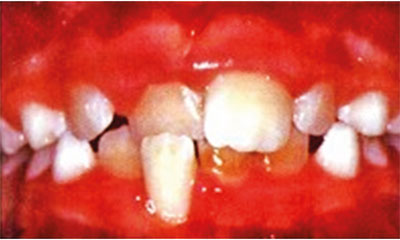
Anterior cross bite
Referring to the management of supernumerary teeth, Dr. Dewanarayana says that it is essential to take an X-ray of the teeth, after which the additional teeth which have erupted should be extracted. Removal of un-erupted teeth should be performed with extreme caution, without damaging the developing roots.
- n Lower incisor crowding – this will resolve spontaneously in some cases with post-natal growth of the mandible and there will only be a need to extract the over-retained primary incisors.
- n Median diastema – this refers to having a space between the two upper central incisors. The treatment can be in the form of the removal of any pathology and orthodontic treatment to correct the problem.
- n Ectopic upper canine – this is when the canine-tooth deviates from its normal eruption path which can be clinically evaluated. This can come about with the prolonged retention of the primary canine tooth.
 It would be indicated by the absence of a labial canine bulge at the age of 10–11 years, the presence of a palatal bulge, delayed eruption or distal tipping of the lateral incisor, missing lateral incisors or presence of peg laterals and non-closure of the median diastema. A radiological assessment should be followed by the extraction of the primary canine if the permanent canine is favourable for eruption. If it does not erupt, surgical exposure and orthodontic treatment should be performed to align the tooth.
It would be indicated by the absence of a labial canine bulge at the age of 10–11 years, the presence of a palatal bulge, delayed eruption or distal tipping of the lateral incisor, missing lateral incisors or presence of peg laterals and non-closure of the median diastema. A radiological assessment should be followed by the extraction of the primary canine if the permanent canine is favourable for eruption. If it does not erupt, surgical exposure and orthodontic treatment should be performed to align the tooth.
- Thumb sucking – there should be a discussion with the child to persuade him/her to stop this habit, with a few months being afforded for the child to do so. If such an attempt is unsuccessful, a habit-breaking device should be introduced to settle the open bite spontaneously.
- Anterior and posterior cross-bites of dental origin – this can be caused by the displacement of teeth and should be treated early to prevent functional shifts and wearing of the erupted permanent teeth.
- Growth modification – the growth of the upper and lower jaws can be modified in a child’s ‘growing’ age when there is disproportionate growth of the jaws. This will correct the malocclusion or reduce the severity of the problem and may prevent the need for surgical intervention in the future.
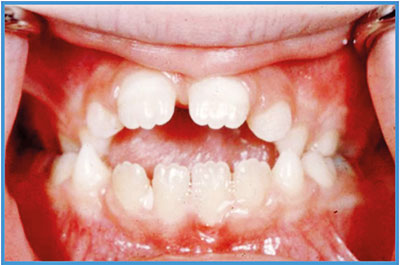
Thumb sucking
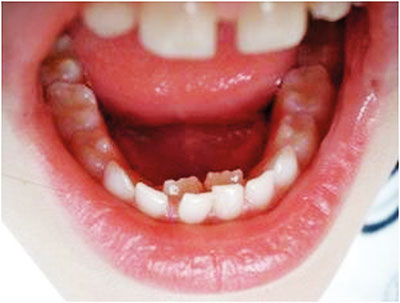
Lower incisor crowding
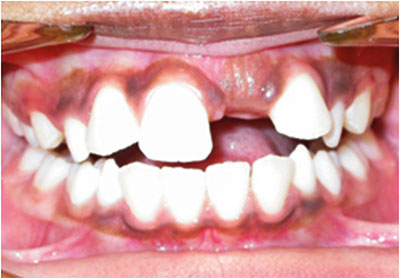
Delayed eruption of upper permanant central incisor
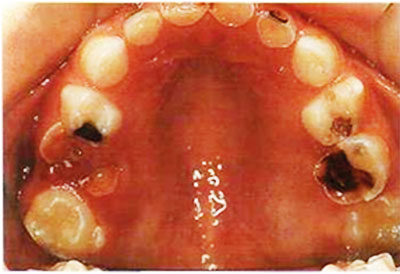
Caries


